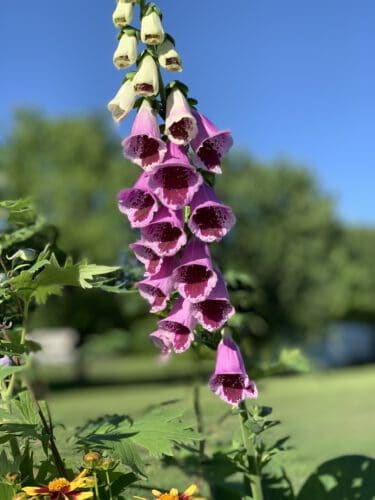Did you know that you can find three different species of hummingbirds in Oklahoma? Two species, the Ruby-throated and the Black-chinned, nest in Oklahoma and are found here during the summer months. The third species, the Rufous Hummingbird, does not nest in Oklahoma, but migrates through the state during the spring and fall.
At GreenPro we know that many of our clients are also huge hummingbird enthusiasts. The easiest way to find these Oklahoma mainstays is to create your own hummingbird garden on your property where they can come and feel at home. Curious about how to begin? Let GreenPro share a few tips for how to create your own hummingbird habitat!
Location
Before planting a hummingbird garden, you should first consider its ideal size and location. A hummingbird garden can be as small as a window box or as large as several acres, so wherever you plant, it should be best positioned so you can see it. Your garden will also need both sun and shade. Hummingbirds like to hum around in the sun; however, they also need shade to rest, cool off, and make a nest for their young.
Flowers
Hummingbirds are very visual creatures; they have terrific sight and love the color red (and other colors). Hummingbirds also like tubular or trumpet flowers like those on the Trumpet Vine. Since hummingbirds are natural pollinators as they travel from flower to flower, those flowers will love being a part of your garden.

When planning your hummingbird garden, remember that hybrid flowers produce less nectar than their wild cousins, which will make them less attractive to hummingbirds. Also, try to select flowers that bloom at different times of the year so that there will always be flowers around. Use a variety of flowers and flower colors so the hummingbirds can be attracted to the diversity of your garden’s ecosystem.
When planting your garden, remember to give some spacing between each plant so the hummingbirds will have space for their wings to hum.
Trees
Bottlebrush, Eucalyptus, and/or Willow are great for a hummingbird garden because they grow nice soft material for the hummingbirds to use in a hummingbird nest.
Moss
Hummingbirds will use moss and lichens to help make a nest because the material is nice and soft for baby hummingbirds.
Bugs
Hummingbird gardens are convenient for many homeowners because of their minimal maintenance, both with plants and getting rid of the pests. Hummingbirds love to eat gnats, aphids, and spiders. Also, you don’t need pesticides in a hummingbird garden; the hummingbirds themselves are great little exterminators.
Feeders
Despite having all these beautiful hummingbird flowers as well as other sources of nourishment, you should install hummingbird feeders in your hummingbird garden. Flowers go in and out of bloom and aggressive hummingbirds will declare a flower theirs. Having an extra feeder or two offers the nectar a hummingbird needs (they need to eat every 15-20 minutes). It is also another great way to get a good look at them.
Water
Water is crucial to a hummingbird garden because hummingbirds need water to drink and to bathe. A small birdbath or even a bowl works very well. Make sure you change out the water every other day or so to prevent mosquitoes from breeding. Also, try putting in a water mister so the hummingbirds can take a shower.
Want to get a closer look at the Ruby-throated hummingbird or admire the Black-chinned hummingbird? Call GreenPro today; we’ll work with you to create a hummingbird habitat that will allow these Oklahoma mainstays to nest on your property!
